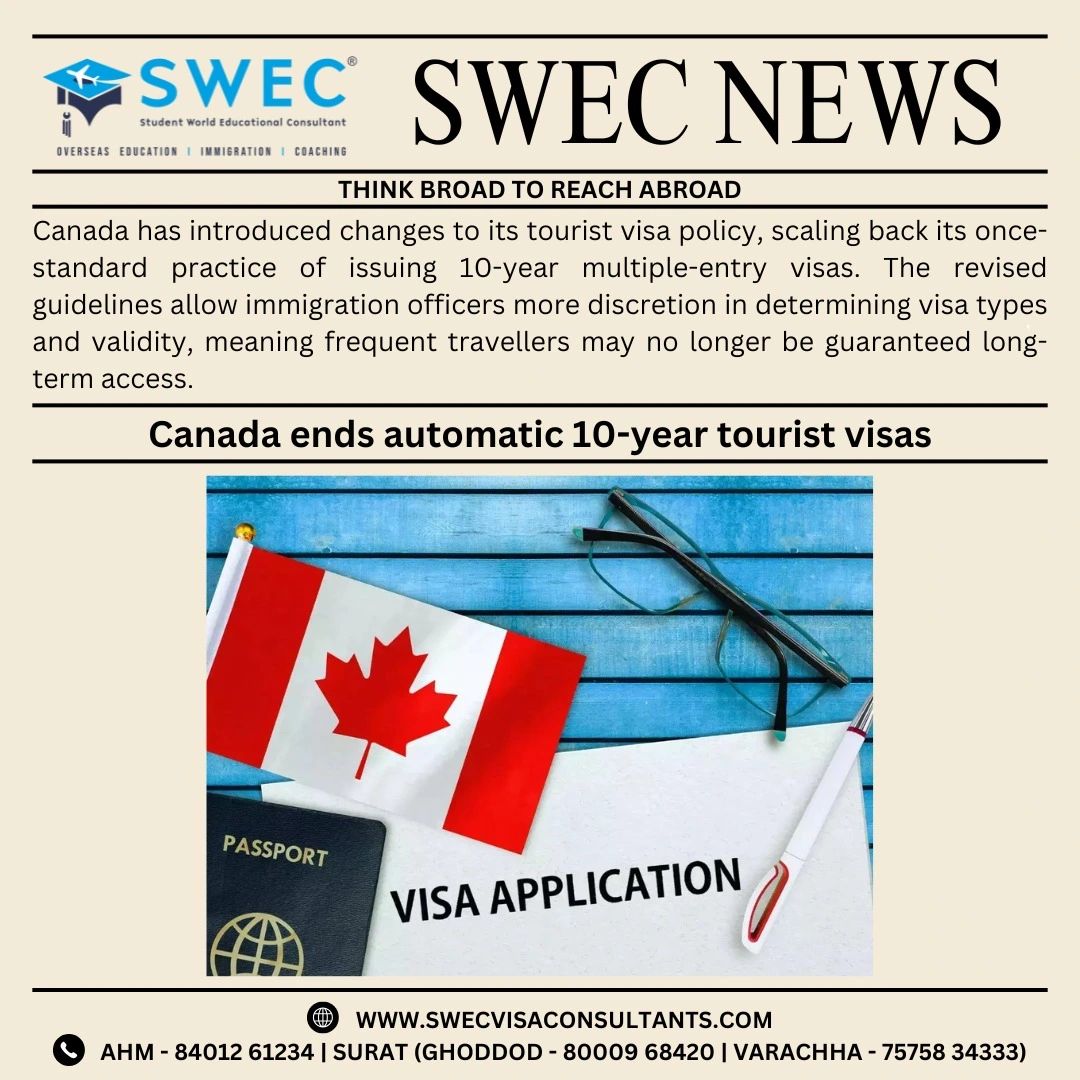In a significant shift, Canada has revised its tourist visa policy, moving away from its practice of routinely issuing 10-year multiple-entry visas. This new update gives immigration officers greater discretion when determining the type and validity of visas issued. As a result, frequent travellers to Canada may no longer receive long-term visas automatically, a change that reflects the evolving approach of Immigration, Refugees, and Citizenship Canada (IRCC) towards temporary immigration.
More Discretion for Immigration Officers
Under the updated guidelines, IRCC aims to provide a more tailored approach to visa issuance. In the past, it was common for eligible applicants to receive multiple-entry visas valid for up to 10 years, allowing them to visit Canada numerous times without needing frequent reapplications. However, with the new policy, immigration officers will now evaluate each application individually, considering the applicant’s purpose of travel, travel history, and other relevant factors. Based on this assessment, officers may issue shorter-term visas or limit the validity period if deemed necessary.
According to IRCC, this change aims to better manage temporary immigration levels and ensure that visa issuance aligns with Canada’s broader economic and social policies, especially amidst growing concerns about the country’s housing shortage and increased cost of living. By allowing officers to exercise judgment in issuing visas, the government hopes to control the influx of temporary visitors who might contribute to the rising demand for housing and services.
Impact on Frequent Travelers
This policy shift may lead to increased costs and added logistical challenges for frequent travellers to Canada, as they may need to reapply for visas more frequently than before. For those who regularly visit Canada for business or personal reasons, the lack of automatic long-term visas could mean more frequent applications, additional fees, and a more stringent review process.
IRCC’s updated guidelines clearly state that multiple-entry visas with a maximum 10-year validity are no longer the standard. Instead, the decision on whether to grant a single-entry or multiple-entry visa, as well as the length of validity, will be made on a case-by-case basis.
The official statement from IRCC reads:
“Guidance has been updated to indicate that multiple-entry visas issued to maximum validity are no longer considered to be the standard document. Officers may exercise their judgment in deciding whether to issue a single or multiple-entry visa and in determining the validity period.”
Overview of Recent Changes in Tourist Visa Issuance
| Visa Type | Previous Policy | Updated Policy |
| Multiple-Entry Visa | Commonly issued with 10-year validity | Issuance and validity at the officer’s discretion |
| Single-Entry Visa | Issued based on specific travel purposes | May become more common under new guidelines |
| Validity Assessment | Standard 10 years for eligible applicants | Individual assessment for the validity period |
| Travel Costs | Lower due to long-term visa issuance | Potential increase due to frequent reapplication |
This update marks a significant departure from Canada’s previous immigration strategy, indicating a more cautious and controlled approach to managing the flow of temporary residents.
Conclusion
The recent changes in Canada’s tourist visa policy reflect a strategic shift by IRCC to better manage immigration levels and address concerns related to housing and the cost of living. While the new guidelines may result in increased application frequency and shorter visa durations for some travellers, they aim to align temporary immigration with Canada’s current socio-economic goals. If you’re planning to visit Canada, it is crucial to stay informed about these updates and prepare accordingly. For personalized assistance and expert guidance on your visa application, consult SWEC’s experienced visa consultants to ensure a smooth and hassle-free process.
FAQs
Q1. What has changed in Canada’s tourist visa policy?
Ans1. Canada has revised its policy of automatically issuing 10-year multiple-entry visas. Immigration officers now have more discretion in deciding the type of visa and its validity, based on individual applicant assessments.
Q2. Why did Canada end the automatic 10-year tourist visas?
Ans2. The decision was driven by concerns over rising temporary immigration levels, housing shortages, and increasing costs of living. The policy change aims to better manage the flow of temporary visitors.
Q3. Will frequent travellers still be eligible for long-term multiple-entry visas?
Ans3. While long-term multiple-entry visas are not entirely discontinued, their issuance is no longer guaranteed. Immigration officers will now evaluate each case individually and may grant shorter-term visas based on the applicant’s travel history and purpose.
Q4. How does the new policy impact travellers to Canada?
Ans4. Frequent travellers may face increased costs and the need to apply for visas more frequently. The new approach could result in shorter visa validity periods and more stringent assessments.
Q5. What factors will immigration officers consider when issuing visas under the new guidelines?
Ans5. Officers will assess factors such as the applicant’s purpose of visit, travel history, ties to their home country, and potential impact on Canada’s housing and social services.
Q6. Can applicants still apply for multiple-entry visas?
Ans6. Yes, applicants can still apply for multiple-entry visas, but the decision to grant one will be based on the immigration officer’s evaluation of the applicant’s profile and travel needs.
Q7. What is the difference between a single-entry and multiple-entry visa under the new policy?
Ans7. A single-entry visa allows one-time entry into Canada for a specific purpose, while a multiple-entry visa permits multiple visits during its validity period. Under the new policy, the decision to issue either will depend on individual assessments.
Q8. How might this policy change affect Canada’s immigration targets?
Ans8. By exercising more discretion in visa issuance, Canada aims to control the number of temporary residents, thereby aligning immigration levels with housing availability and reducing strain on public services.
Q9. When will the new visa guidelines take effect?
Ans9. The new guidelines are already in effect, as announced by IRCC. Travellers planning to visit Canada should consider these changes when applying for their visas.
Q10. How can SWEC help with the new Canadian visa process?
Ans10. SWEC offers expert visa consultancy services to help applicants navigate the new visa requirements. Our experienced team provides personalized guidance to increase the chances of a successful application. Contact SWEC today for a consultation!





